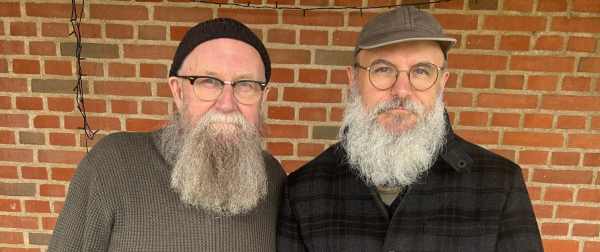

Vaev
Vaev is the Danish duo of well-known fiddler Poul Lendal (of Lang Linken, Harpens Kraft et al.) who, as well as fiddle, here plays spoons, rummelpot (friction drum), seljefløjte (no-hole whistle) and jew’s-harp, and David Mondrup, who’s the laptopper but also contributes piano and other keyboards described as ‘with and without bellows.’
The album begins with what at first, apart from its wackety-percussive laptop intro, seems to be a fairly standard, pleasingly bouncy version on fiddle and piano of two 2/4 tunes, “Den toppede høne” and “Rejlånder.” A pitched bass drum sound joins in - not leaden beats, but a very natural sounding skipping double pulse. Then things change; that first tune carries on, but subtly sound-altered, and there’s a new, shuffling sound. With the switch and key-change to the rejlånder (what in Norwegian gammeldans is called a reinlander, also known in various languages, variously spelt, as a schottische) things get briefly nicely electronically weirder before Swedish guest Mats Edén strikes up on one-row melodeon, when the sound again seems more or less acoustic, but soon an attractively lurching mangling increases to an ending of chopped-up chaos. The simple, nursery-rhyme type tune of the waltz “Øst og Vest” gets vocals from the pair over its springy, chugging rhythm, the fiddle moving from chopping to bowing as the key changes for another perky, swingy waltz, “Jysk på næsen.” Guest Mia Guldhammer sings “Gid alle de bjerge”, soon joined by a processed backing choir, and towards the end fiddle takes over in another waltz. In Lendal’s composition “Hans Majestæt,” from a quiet start Hans Mydtskov’s tenor sax creeps in with the winding tune, to a background of electronically altered sounds, warped organ-like lead takes over for a break, and after a short percussion interlude the tune’s in again, with sax, distorted bass clarinet and cello briefly in canon, to a scattering coda.
“Karen fra dansen / Skottis” is a song and schottische in swinging, clumping 4/4 with alternating male and female vocals and raw fiddle to a background of processed party noises. Harmonium over metallic scraping opens the lurching “Klappvalsen” by Mats Edén, who takes over the tune on fiddle together with Lendal, underpinned by a grunting bass rhythm of friction drum; that tune collapses into “Polska.” not the wiggly Swedish Dalarna type but a more regular 3/4, which is later diddle-vocalised by Lendal before Mondrup restates it on piano.
“Rytteren” is a fast-worded song delivered by Mia Guldhammer, segueing into the album-title tune “Sløjfen” (‘the loop’) led first by Lendal’s fiddle then with the fruity graunch of Hans Mydtskov’s baritone and tenor saxes and bass clarinet. In “Pedro Larsen,” laptop booms and surging growl support choppy buzzy jew’s-harp before Lendal’s fiddle and Danish-Iranian guest Rosyán (Rosanna Lorenzen) on cello and laptop deliver a fragmenting version of the traditional tune. Most of the raw material here is traditional, from the repertoires of named musicians or occasionally written sources. But “O Morris,” “Silke” and the aforementioned “Hans Majestæt” are compositions by Lendal, and “Samsø” by Mondrup. “O Morris” is a twirling dance tune on fiddle and harmonium with beefy laptop accompaniment that creates a mental image of a very danceable Danish, or even English, ceilidh band rather than of electronickery. “Silke” opens with echoing, glitched seljefløjte which evolves to play a lively tune in the instrument’s characteristic natural harmonic scale, accompanied by echoing samples of itself with a funky electronic bass line and percussive sounds.
Mondrup’s “Samsø” opens with oud, played by brilliant Denmark-resident Turkish musician Orhan Özgür Turan, which states a repeating melody, shared by Turan’s saz, Mydstkov’s tenor sax and choral voices, that combines Middle-Eastern and Danish characteristics, ending in a jumble of processed street sounds. The album closer, “Fiskervalsen / Rundenom,” features a 1980 recording of one of the named source musicians, Lendal’s father Gert Lendal, on two-row melodeon playing a swaying waltz, joined by Poul on fiddle, before a sudden change of tune to electronic pattering and grunting preceding and accompanying Poul’s fiddle in “Rundenom.” Showing how acoustic and electronic, in the right hands, can really work together in a natural way, it’s an album of music that’s ever-changing, ingenious and all with a dance-impelling spring in its step.
Further listening: |